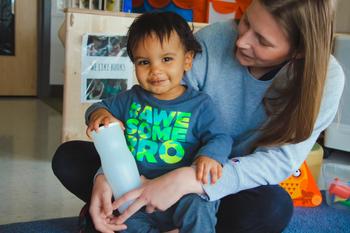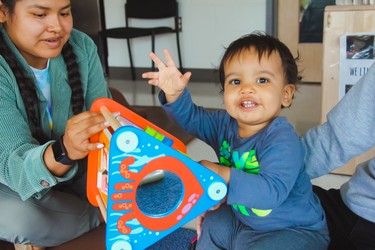Types of Play: The Importance of Schema Play

Do you ever wonder why your child is suddenly throwing everything they can get their tiny little hands on?! Well, not to worry. What you are seeing is “Schema Play” in action and, as frustrating as it can be, it is necessary for brain development.
Schematic play is what happens when infants, toddlers and young children show interest in repeated actions as they explore the world around them and are trying to make sense of how things work. These specific actions or behaviours are called “Schemas”. This type of play is very important to a child’s development. It is self-initiated and often spontaneous. Part of our role as educators at Umbrella is to observe, and then to provide materials and/or experiences as invitations for children to expand on and enhance these learning skill sets that are directly linked to the growth and strengthening of their cognition and overall brain development. You know the saying, “If at first, you don’t succeed, try, try again”? This is it!
Schema Explorations
Child development experts have identified various categories of schema play. The chart below highlights some common schemas that children explore. (Adapted from Children’s Lively Minds: Schema Theory Made Visible, Deb Curtis and Nadia Jabonets, Redleaf Press, June 2019.)
Transporting
Moving objects from one place to another, transporting themselves or others.
– Carrying items from one place to another
– Filling up bins, containers, pockets, etc. to move items from one location to another
Transforming
Combining materials, mixing things together.
- Using various materials to study the changes
- Exploring with paint, water, sand, play dough, etc.
Trajectory
Propelling objects and themselves.
– Moving things through the air by throwing, dropping, rolling, running, swinging, pushing, pulling, launching, etc.
Connecting and Disconnecting
How things are linked together and their relationship with other objects.
– Joining things together, connecting and disconnecting objects
Rotation and Circularity
Things that rotate, spin, roll, twist and exploring circles and curves.
– Spinning objects and themselves
– Exploring wheels, knobs and things that turn, twist, roll
– Drawing curved lines and circles
Orientation and Perspective
Exploring different viewpoints.
– Getting into interesting positions (e.g. upside down, up high, down low, underneath)
– Looking through translucent objects, mirrors
Positioning and Ordering
Noticing similarities and differences, sorting and classifying objects and people.
– Arranging or lining up materials, objects, or themselves in a certain way
– Finding patterns
Enclosing and Enveloping
Covering up and containing items and themselves.
– Creating boundaries or borders around objects
– Filling containers
– Climbing into spaces
– Hiding objects
Our role as educators is to observe children as they engage in the various types of schema play and provide responsive opportunities for them to build upon and strengthen these developing cognitive functions of their brain. Whether the children are stacking, throwing, opening/closing, weaving things in and out or moving objects from one place to another, we will be sure to provide opportunities to support their interests.


